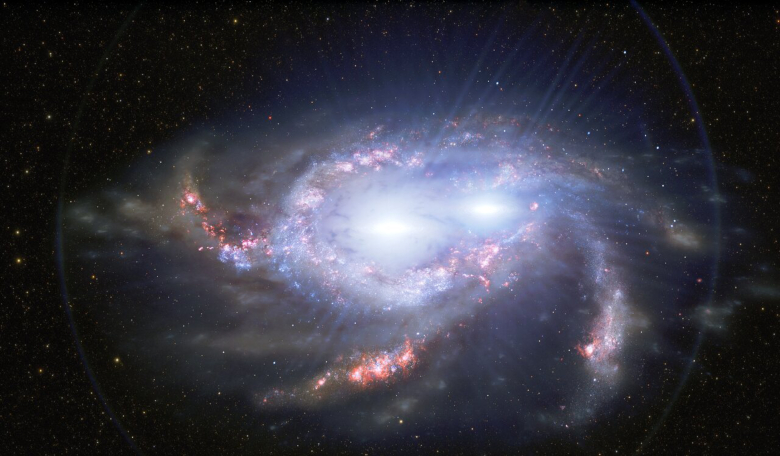Astronomers have found two close pairs of quasars in the distant Universe that are closer together than any pair of quasars found so far away. Seen when the Universe was less than four billions years old, these behemoth objects provide strong evidence for the existence of supermassive black hole pairs as well as a crucial insight into galaxy mergers in the early Universe.
Lighting up the way to the heart of a feeding black hole is an accretion disk so bright, its luminosity is enough to outshine the light emitted from entire galaxies.
Known as active galactic nuclei (AGN), these incredibly energetic objects feed with such ferocity, powerful jets can be shot out that are larger in extent than their host galaxy.
This type of AGN is known as a quasar, a term short for a “quasi-stellar radio sources," because at one time, the radiation emitted from these point-like sources was thought to consist of strong radio waves. After further research however, it turns out that only about 10 percent of quasars emit radio waves of this nature.
On their own, quasars can be used by astronomers as background light sources to study the intervening galaxies and diffuse gas.
But as a pair their scientific interest increases significantly. Especially ones in the distant past. “It is estimated that in the distant Universe, for every one thousand quasars, there is one double quasar,” says Yue Shen, an astronomer at the University of Illinois. “Finding these double quasars is like finding a needle in a haystack.”
Shen is the lead author of this new study which identified not one, but two close pairs of quasars and in each pair, the two quasars are separated by only about 10,000 light-years.
Their discovery is the result of numerous complex observations which the team completed with the help of several space and ground-based telescopes, because despite their enormous size and energy output, finding quasar pairs in the early Universe is incredibly difficult to do.
To focus their search, the team first identified 15 quasars for further investigation using the Sloan Digital Sky Survey, a programme which ran from 2000 to 2008 and at the time created the most detailed three-dimensional maps of the Universe ever made.
From this list Shen and colleagues then used observations from the European Space Agency’s Gaia spacecraft to identify four potential quasar pairs, that were narrowed down to two pairs with the help of the Hubble Space Telescope.
Finally, the team used the the Gemini Multi-Object Spectrograph (GMOS) on Gemini North to hone in on the properties of one of the quasar pairs.
Gemini is an observatory consisting of two telescopes, Gemini North and Gemini South, located at two separate sites in Hawaii and Chile respectively. Its spectrograph provided the team with independent measurements of the distance to the quasars, their chemical composition and helped confirm that the two quasars are indeed a pair rather than a chance alignment of a single quasar with a foreground star.
“The Gemini observations were critically important to our success because they provided spatially resolved spectra to yield redshifts and spectroscopic confirmations simultaneously for both quasars in a double,” explained Yu-Ching Chen, a graduate student at the University of Illinois who is on the discovery team. “This method unambiguously rejected interlopers due to chance superpositions such as from unassociated star-quasar systems.”
While the team believe that this very uncommon discovery is robust, there is a small possibility that double images of single quasars could have been observed instead of a pair of quasars.
This would occur due to a phenomena known as gravitational lensing, and it happens when an intervening massive galaxy distorts and splits the light from a distant object, often resulting in multiple images of that object.
Shen and colleagues are very confident that their pair of quasars are just that, as no foreground galaxies were detected in their observations.
“This truly is the first sample of dual quasars at the peak epoch of galaxy formation,” team member Nadia Zakamska of Johns Hopkins University says.
The team will now use the pair of quasars to probe ideas about how supermassive black holes come together to eventually form a binary.
“This proof of concept really demonstrates that our targeted search for dual quasars is very efficient,” concluded Hsiang-Chih Hwang, a graduate student at John Hopkins University and the principal investigator of the Hubble observations. “It opens a new direction where we can accumulate a lot more interesting systems to follow up, which astronomers weren’t able to do with previous techniques or datasets.”











